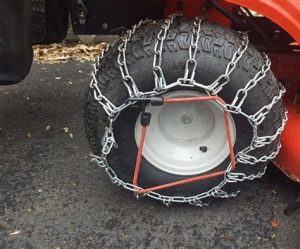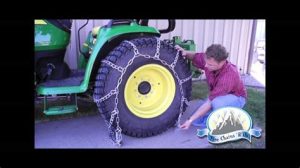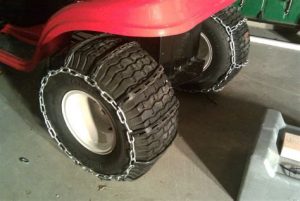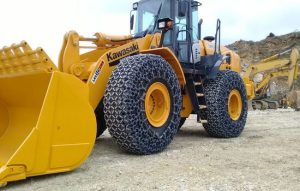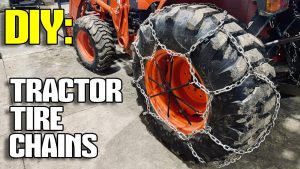Discover essential tips for tire maintenance, selecting tractor chains, pre-installation inspections, installation steps, and the benefits of properly installed chains for optimal performance.When it comes to maximizing the performance and safety of your tractor, one often-overlooked aspect is tire maintenance—specifically, the installation of tire chains. Whether you’re navigating through icy farm roads in winter or tackling muddy fields after heavy rainfall, chains can provide the necessary grip to keep your tractor moving efficiently. This blog post will guide you through the essential tips for installing chains on your tractor tires, ensuring that you not only enhance traction but also extend the lifespan of your tires. From understanding the importance of proper maintenance to choosing the right chains, conducting pre-installation inspections, and following a step-by-step installation guide, we aim to equip you with the knowledge needed for this essential task. Join us as we explore the myriad benefits of properly installed chains and how they can make a significant difference in your farming operations.
Importance of Proper Tire Maintenance
Proper tire maintenance is crucial for the longevity and performance of your vehicle. Tires are the only points of contact between your vehicle and the road, making their upkeep essential for safety and efficiency. Regular maintenance not only extends the life of the tires but also enhances fuel efficiency and driving comfort.
One of the most significant aspects of tire maintenance is regular inspection. This includes checking for signs of wear, irregularities in tread depth, and ensuring that they are properly inflated. Under-inflated tires can lead to increased wear and reduce fuel efficiency, while over-inflated tires can decrease traction and make driving unsafe.
In addition to inspection, rotating your tires regularly can help achieve even wear across all tires, thereby increasing their lifespan. It is generally recommended to rotate your tires every 5,000 to 7,500 miles, or as specified by your vehicle manufacturer.
Choosing the Right Chains for Your Tractor
When it comes to ensuring optimal performance and safety for your tractor, choosing the right chains is paramount. The correct chains can enhance traction, stability, and overall productivity, especially in tough conditions. However, with several options available, understanding what to look for is essential.
- Chain Type: There are various types of chains such as link type, ladder type, and diamond pattern. Each has its benefits, depending on your specific needs.
- Size: Chains must fit properly. Always refer to your tractor’s manual to determine the right chain size compatible with your tires.
- Material: Chains can be made from different materials, including steel and alloy. Steel chains provide excellent durability while alloy chains are often lighter.
Additionally, consider the soil and weather conditions where you will primarily use the tractor. For instance, if you regularly operate in icy or muddy terrain, select chains designed for those environments. Ultimately, making an informed decision will enhance your tractor’s performance and prolong its lifespan.
Pre-Installation Inspection of Your Tires
Before you install chains on your tractor tires, it’s essential to perform a pre-installation inspection. This step ensures that you identify any potential issues that could affect the performance and safety of your tractor.
- Tire Condition: Check for any signs of wear and tear, including cuts, bulges, or uneven wear. Tires with damage should be replaced before installation.
- Tire Pressure: Ensure that all tires are properly inflated to the manufacturer’s specifications. Under-inflated or over-inflated tires can affect chain performance.
- Tread Depth: Measure the tire tread depth to ensure it meets the minimum requirements for safe operation. Insufficient tread can compromise traction, even with chains installed.
- Cleanliness: Clean the tires thoroughly to remove any dirt, debris, or ice. This will help the chains fit more securely and perform better.
- Tire Size: Ensure that you have the correct chain size for your specific tire model. Using incorrectly sized chains can lead to insufficient performance or damage during operation.
By conducting this thorough pre-installation inspection, you can ensure the safety and efficiency of your tractor when using chains. Addressing any issues before installation can save you time and prevent potential hazards in the field.
Don’t overlook the importance of regular maintenance checks as well; keeping tabs on tire health can significantly increase the longevity of your tractor’s tires and chains.
Remember, a little time spent on an inspection can go a long way in maintaining your tractor’s performance and ensuring a safe working environment.
Step-by-Step Guide to Installing Chains
Installing chains on your tractor tires is a crucial process that enhances traction during harsh weather conditions or on slippery surfaces. Proper installation ensures optimal performance, safety, and longevity of the chains. Here, we provide a comprehensive step-by-step guide to help you install your chains effectively.
- Chains suitable for your tractor tires
- Measuring tape
- Tire gauge
- Gloves
- Jack (if needed)
Ensure that your tractor is parked on a level surface. If necessary, use a jack to lift the tractor and give yourself extra room to work. This makes it easier to install the chains without interference.
Before installing the chains, measure the tire size. This is important to ensure that you have the right length and type of chains for your specific tires.
Spread out the chains on the ground to remove any tangles. This will make it easier to manage and connect them around the tires.
Starting with the inside of the tire, drape the chains over the tire. Make sure that the chains are evenly distributed across the tread and that the hooks or fasteners are facing outward for easy access.
Use the hooks and fasteners to secure the chains around the tire. Ensure they are tight but not excessively so, as this could damage the tire or chains.
Once the chains are installed, roll the tractor forward a few feet and inspect the chains for proper fit. Ensure they’re not rubbing against any part of the tractor. If necessary, adjust them for a more secure fit.
Conduct a final inspection to check that the chains are secure and functioning correctly. Make adjustments if necessary before using your tractor in the field.
By following these steps, you’ll ensure a successful installation of chains on your tractor tires, enhancing safety and performance in various conditions.
Benefits of Properly Installed Chains
Installing chains on your tractor tires can significantly enhance traction and stability, especially in adverse weather conditions. Properly installed chains provide increased grip on slippery surfaces such as snow, ice, or muddy terrain, which is essential for ensuring safety while operating heavy machinery.
Another important benefit of well-installed chains is the reduction of tire wear and tear. By distributing weight evenly across the tire surface, chains can protect the rubber from damage caused by sharp objects or rough terrain. This results in extended tire life, saving you money in the long run by minimizing the need for frequent tire replacements.
Additionally, using chains can enable your tractor to perform better in challenging conditions, allowing you to complete tasks more efficiently. Whether you are plowing fields or navigating through rocky landscapes, properly installed chains can boost your tractor’s performance, ensuring you get the job done without unnecessary delays.
Frequently Asked Questions
Why is it important to install chains on tractor tires?
Installing chains on tractor tires enhances traction, especially in wet, muddy, or snowy conditions, allowing for better performance and safety while operating the tractor.
What type of tire chains are best for tractors?
The best type of tire chains for tractors are usually V-bar chains or heavy-duty ladder chains, as they provide maximum grip and durability for agricultural tasks.
How do I choose the right size of chains for my tractor tires?
To choose the right size of chains for your tractor tires, you need to measure the tire’s width and diameter, then refer to the manufacturer’s sizing chart for compatibility.
What tools do I need for installing chains on tractor tires?
Essential tools for installing chains on tractor tires include a pair of gloves, a measuring tape, and possibly a chain tensioner or bungee cords for securing the chains tightly.
What is the best technique for installing tire chains?
The best technique involves laying the chains flat on the ground, driving the tractor onto them, and then adjusting and securing the chains around the tires evenly to ensure proper fit.
Can I install chains on my tractor tires myself, or should I hire a professional?
You can install chains on your tractor tires yourself with some basic knowledge and tools, but if you’re unsure or uncomfortable, hiring a professional is recommended for safety.
How often should I check and maintain my tire chains once installed?
You should check and maintain your tire chains regularly, especially before and after each use, to ensure they are in good condition, properly tensioned, and free of rust or damage.
